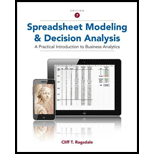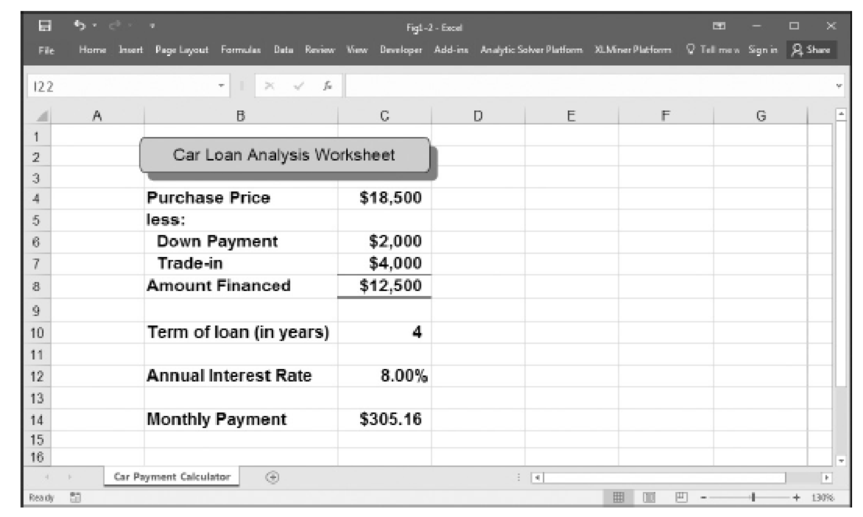
Spreadsheet Modeling and Decision Analysis: A Practical Introduction to Business Analytics
7th Edition
ISBN: 9781285418681
Author: Cliff Ragsdale
Publisher: Cengage Learning
expand_more
expand_more
format_list_bulleted
Concept explainers
Textbook Question
Chapter 1, Problem 18QP
Consider the spreadsheet model shown in Figure 1.2. Is this model descriptive, predictive, or prescriptive in nature, or does it not fall into any of these categories?
Figure 1.2
Example of a simple spreadsheet model

Expert Solution & Answer
Want to see the full answer?
Check out a sample textbook solution
Students have asked these similar questions
Define Total Quality Management. Why has TQM played an important role in the current business environment? How important is TQM in international business?
Compare and contrast leadership to management. Be sure and site examples of both leadership and management.
List and define the most important management concept that you saw in the class. How did the definition or understanding of this concept differ from what you thought it was when you first started in the class?
Chapter 1 Solutions
Spreadsheet Modeling and Decision Analysis: A Practical Introduction to Business Analytics
Ch. 1 - Prob. 1QPCh. 1 - Prob. 2QPCh. 1 - Prob. 3QPCh. 1 - Prob. 4QPCh. 1 - What is the relationship between business...Ch. 1 - What kinds of spreadsheet applications would not...Ch. 1 - Prob. 7QPCh. 1 - Prob. 8QPCh. 1 - What is a dependent variable?Ch. 1 - What is an independent variable?
Ch. 1 - Can a model have more than one dependent variable?Ch. 1 - Can a decision problem have more than one...Ch. 1 - Prob. 13QPCh. 1 - Prob. 14QPCh. 1 - In what ways are descriptive models different from...Ch. 1 - Prob. 16QPCh. 1 - Prob. 17QPCh. 1 - Consider the spreadsheet model shown in Figure...Ch. 1 - Prob. 19QPCh. 1 - Prob. 20QPCh. 1 - Prob. 21QPCh. 1 - Prob. 22QPCh. 1 - Prob. 23QPCh. 1 - Prob. 24QPCh. 1 - Prob. 25QPCh. 1 - Prob. 26QPCh. 1 - Prob. 27QP
Knowledge Booster
Learn more about
Need a deep-dive on the concept behind this application? Look no further. Learn more about this topic, management and related others by exploring similar questions and additional content below.Similar questions
- Instructions: We discussed the ten knowledge areas for project managers, in the chart below list the 10 knowledge areas, and give an example of how a project manager might demonstrate these areas through the project management process, and in the third column list some tools or techniques the project manager might use to complete these scenarios. Knowledge Area Example of knowledge Tools or Techniques 1. Integration management 2. Scope management 3. Schedule management 4. Cost management 5. Quality management 6. Resource management 7. Communications management 8. Risk management 9. Procurement management 10. Stakeholder management What are some project roles? What are some tools that are extensively used that improve project importance?arrow_forwardRead the following HuffPost article https://www.huffpost.com/entry/middle-manager-burnout_l_66390d92e4b0f72991a70fff Scenario: You are a highly productive employee and have recently been offered a promotion to become a manager of your department. You are offered a salary that is 10% higher than your current hourly pay. The change for promotion to the next management level is highly likely although it may take a few years for the position to become available. You have been told that you would be a perfect fit for the potential promotion. Based on the information in the article would you take the promotion? Why or why not?arrow_forwardRead the following HuffPost article https://www.huffpost.com/entry/middle-manager-burnout_l_66390d92e4b0f72991a70fff As presented in the article, describe three situations that are challenges for middle managers. As presented in the article, describe three ways in which a middle manager might address his/her work challenges.arrow_forward
- Read the following HuffPost article https://www.huffpost.com/entry/middle-manager-burnout_l_66390d92e4b0f72991a70fff Scenario: You are a highly productive employee and have recently been offered a promotion to become the manager of your department. You are offered a salary that is 1.5 times higher than your current hourly pay. The chance for promotion to the next management level is improbable. Based on the information presented in the article, would you take the promotion? Why or why not?arrow_forwardIn an age when going digital is an unavoidable business decision, understanding how digital entrepreneurship influences the formation and development of successful Multinational Enterprises (MNEs) has been a crucial topic in international business studies. While digital entrepreneurship has been seen as a challenge and disruption in some recent literature, is it possible that businesses may be able to find their opportunities during digitalization? Mainly, how can the internationalization process of business be consciously/actively or unconsciously/and passively motivated and reformed by the digitalization trend?arrow_forwardWhat are in your opinion the digital strategies and tools that can foster the development of the Industry 4.0 ?arrow_forward
- Corporate Responsibility has been a 'buzz word' in the last few years. There is no doubt that each organization should exhibit corporate responsibility. When did corporate responsibility gain impetus and why? Which company(ies) can be given credit for leading the way for corporate responsibility?arrow_forwardDefining the scope of an information technology project is a challenging task due to the uncertainties in time, cost, technologies, quality, human resources, and so on. Address the following questions. How would techniques of project scope management ensure the project objectives can be achieved in an information technology project? Can any of the agile approaches be engaged in the project scope management for a better efficiency?arrow_forwardDirections: In Chapter 1 we introduce Project Management. Why is there a new or renewed interest in project management? 2. What is a project? What are its main attributes? What are some examples of different size projects? 3. What are project constraints? How do they affect the project management process? 4. What is the relationship between Projects, and operations? 5. What are some skills recommended for project managers? Why would these skills be important in the management of projects? 6. What is the PMI Talent Triangle and what role do they play in the project management field?arrow_forward
- Do you think businesses ever mistakenly cling to outdated ideas of "acceptable" profit, even as their industry conditions shift?arrow_forwardQuestion 2/60 Correction is always better than: Maintenance Containment Root cause identification Preventionarrow_forwardQuestion 47 / 60 Root cause is related to: The "x" on y=f(x) The "y" on y=f(x) The "=" on y=f(x) The "f" on y=f(x)arrow_forward
arrow_back_ios
SEE MORE QUESTIONS
arrow_forward_ios
Recommended textbooks for you
 Practical Management ScienceOperations ManagementISBN:9781337406659Author:WINSTON, Wayne L.Publisher:Cengage,MarketingMarketingISBN:9780357033791Author:Pride, William MPublisher:South Western Educational Publishing
Practical Management ScienceOperations ManagementISBN:9781337406659Author:WINSTON, Wayne L.Publisher:Cengage,MarketingMarketingISBN:9780357033791Author:Pride, William MPublisher:South Western Educational Publishing Contemporary MarketingMarketingISBN:9780357033777Author:Louis E. Boone, David L. KurtzPublisher:Cengage Learning
Contemporary MarketingMarketingISBN:9780357033777Author:Louis E. Boone, David L. KurtzPublisher:Cengage Learning

Practical Management Science
Operations Management
ISBN:9781337406659
Author:WINSTON, Wayne L.
Publisher:Cengage,

Marketing
Marketing
ISBN:9780357033791
Author:Pride, William M
Publisher:South Western Educational Publishing

Contemporary Marketing
Marketing
ISBN:9780357033777
Author:Louis E. Boone, David L. Kurtz
Publisher:Cengage Learning
Introduction to Forecasting; Author: Ekeeda;https://www.youtube.com/watch?v=5eIbVXrJL7k;License: Standard YouTube License, CC-BY